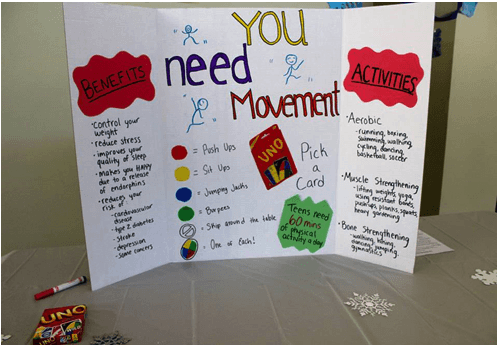8.13: How Can I Stay FIT COY
- Page ID
- 14103
Learn:
- Learn a fun way to exercise that will get your heart rate going and be physically fit.
To Give Out: How I stay Fit Tip Sheet
Tools:
- UNO Card Game
- Signage and handouts
- Yoga Mats
- Music and a way to play it loudly (Optional)
- Feedback survey, pencils, and collection box
Set-up:
- Set up your demo table ahead of time with exercise equipment in an open and accessible area.
- Display signage/ poster to highlight the goal of your demo, and promotes physical activity demonstration (i.e. key terms, fun facts)
- Using a box of UNO Cards, assign an exercise to each color card: red, yellow, blue, green.
- Activities can include, but are not limited to: squats, push-ups, lunges, star jumps, sit-ups, jumping jacks, etc.
- Note: Male and female participants may have differing preferences. It is best to choose enough options to appeal to both.
- Assign an exercise or action to the wild and skip cards
- Example: Wild: One of each exercise, Skip around the table.
- Ensure you have all the equipment you need for the exercises choices.
- Practice the exercises you have chosen beforehand, so you feel confident. Look up correct form for exercises you are unsure about.
- Create or gather the remaining materials you need for the demo (see Toolkit).
- Identify student leaders who will help with the demonstration, and explain to them what the different components of the activity are. Allow them to choose a role they are interested in. Examples: DJ, Timer/Counter, Exercise Demonstrator.
- Research areas and groups in the school or community where students have the opportunity to engage in physical activity.
Script:
- How you stay physically active in your school or community?
- What kind of physical activities do you do at home?
- Did you know physical activity helps reduce stress?
- Did you know physical activity can help reduce cardiovascular disease and obesity?
Activity:
- Have each participant draw an UNO card.
- Point to the sign with legend that explains what each card represents:
- Color = type of exercise
- Number = how many times to do the exercise
- Wild card = one of each exercise
- Skip = skip around the table
- Have student leader explain or demonstration to the participants what safe from looks like for the exercises.
- Have the participants quickly demonstrate they an do the exercise safely.
- Participants perform the exercise for their UNO card, with the number of repetitions designated by the number on the card.
- Cue students during exercise if need to adjust their form, and provide positive reinforcement throughout.
- Ask: "What category or categories does this activity fall under? Aerobic, muscle strengthening, and/or bone strengthening?"
- After the activity, ask participants what they noticed about their heart rate and breathing and how they think being active might improve their overall energy level, mood, etc.
- Give participants the opportunity to complete the activity again.
- Ask participant to self-administer the feedback form.
Suggested Information for Board:
Key terms
Fitness: Ability to do daily tasks with energy and without getting tired
Physical Activity: Any movement that requires energy. In other words, any movement one does is actually physical activity.
Exercise: Movement of the body that uses energy that is planned, structured, repetitive, and purposive usually to improve fitness.
Frequency: Number of times an exercise or activity is performed and expressed in sessions, episodes, or bouts per week.
Intensity: How much work (force, weight, or the magnitude of the effort) is required to perform any physical activity or exercise.
Repetition: Number of times a person lifts a weight for example.
Duration: How long (how much time) you spend doing an activity in one session.
Aerobic: Exercises when the body's large muscles move in a rhythmic manner for a sustained period of time (similar to cardiorespiratory endurance).
Muscle-Strengthening: Exercises that make muscles do more work than usual by holding against an applied force or weight.
Bone-Strengthening: Exercises that produces an impact or force on the bones
Flexibility: Exercises that improves the ability of a joint to move through its full range if motion.
Metabolic Equivalent (MET): The MET is a unit used to estimate the amount of oxygen used by the body during physical activity. The harder the body works, the higher the MET.
- Teens should aim to accumulate a minimum of 60 minutes of moderate vigorous physical activity every day. Teens should include muscle strengthening activities two to three days per week.
- Regular physical helps reduce stress, symptoms of depression and anxiety and improves your mood, quality of sleep, self-esteem, memory and focus.
- Aerobic exercise is a good way to prevent diseases such as type 2 diabetes, depression, cardiovascular disease, osteoporosis and some cancers.
- Trained, very active, individuals have lower resting heart rates than untrained, sedentary, individuals. As you become more cardiovascular fit, your heart doesn't have to work as hard at rest to do its job! This happens as a result of getting your heart rate up during regular physical activity.
- Healthy adults inhale and exhale and average of 7 to 8 liters of air per minute.

Resources:
Harvard. "Physical Activity." www.hsph.harvard.edu/obesity-prevention-source/obesity-causes/physical-activity-and-obesity/#references.
Centers for Disease Control & Prevention. "Aerobic, Muscle- and Bone-Strengthening: What Counts?" www.cdc.gov/physicalactivity/basics/children/whatcounts.htm
Harvard Health Publications. "Strengthening Your Core: Right and Wrong Ways to do Lunges, Squats, and Planks."
www.health.harvard.edu/blog/strengthening-your-core-right-and-wrong-ways-to-do-lunges-squats-and-planks-201106292810
Teens Health. "Why Exercise is Wise." kidshealth.org/en/teens/exercise-wise.html?WT.ac=t-ra

